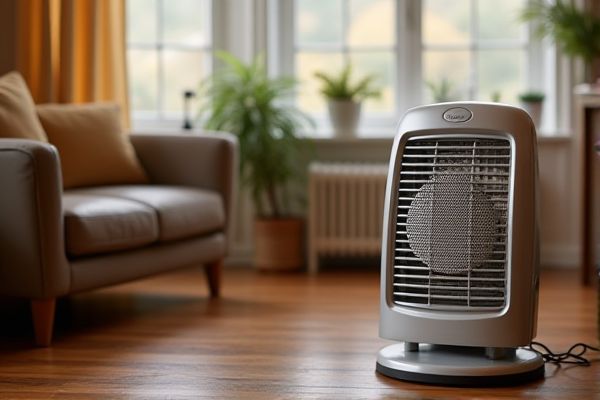
Upright heaters offer powerful warmth and cover larger spaces efficiently, making them ideal for heating entire rooms, while tabletop heaters provide convenient, localized heat perfect for small areas or personal use. Discover which heater best suits Your needs by exploring the detailed comparisons in the rest of the article.
Table of Comparison
| Feature | Upright Heater | Tabletop Heater |
|---|---|---|
| Size | Large, freestanding | Compact, portable |
| Heating Area | Medium to large rooms | Small to medium spaces |
| Power Consumption | Typically higher (1000-1500W) | Lower to moderate (400-1000W) |
| Portability | Less portable, usually fixed | Highly portable, easy to move |
| Placement | Floor placement | Placed on tables or desks |
| Heating Technology | Convection, fan-forced | Infrared, ceramic |
| Cost | Moderate to high | Affordable to moderate |
| Safety Features | Overheat protection, tip-over switch | Overheat protection |
| Best Use | Heating entire rooms | Personal heating, small areas |
Introduction to Upright and Tabletop Heaters
Upright heaters offer powerful heating with larger coverage areas, making them ideal for warming entire rooms efficiently. Tabletop heaters provide compact, portable warmth for smaller spaces or personal use, perfect for desks or bedside tables. Choosing the right heater depends on your specific heating needs and the size of the area you want to warm.
Key Differences Between Upright and Tabletop Heaters
Upright heaters typically offer higher heat output and cover larger areas, making them suitable for heating entire rooms, while tabletop heaters are compact and designed for personal or localized heating. Upright models often feature adjustable thermostats and oscillation functions to distribute warmth evenly, whereas tabletop heaters prioritize portability and space-saving design. Energy efficiency varies between models, with upright heaters generally consuming more power due to their size and capacity compared to the smaller, lower-wattage tabletop units.
Design and Portability Comparison
Upright heaters typically feature a vertical design that occupies more floor space but provides widespread heat distribution, making them suitable for larger rooms. Tabletop heaters are compact and lightweight, designed for easy portability and placement on desks or small surfaces, ideal for personal use. The design of upright heaters often includes built-in handles for moderate mobility, while tabletop heaters excel in convenience due to their small size and minimal setup requirements.
Heating Efficiency and Coverage Area
Upright heaters generally offer higher heating efficiency and cover larger areas due to their taller design and often higher wattage, making them ideal for heating entire rooms quickly. Tabletop heaters provide concentrated warmth suitable for small spaces or personal use, with efficient heating directed around your immediate vicinity. Selecting between the two depends on your desired coverage area and how efficiently you want to warm your living or working space.
Energy Consumption and Cost Analysis
Upright heaters typically consume more energy due to their larger heating elements designed to warm bigger spaces, leading to higher operational costs compared to tabletop heaters. Tabletop heaters are more energy-efficient for smaller areas, reducing your electricity bills by targeting heat precisely and minimizing wasted energy. Choosing the right heater based on room size can optimize energy consumption and lower overall heating expenses.
Safety Features of Upright vs Tabletop Heaters
Upright heaters often come with advanced safety features such as tip-over protection and overheat shutoff, designed to minimize fire hazards in larger spaces. Tabletop heaters prioritize compactness but include essential safety mechanisms like cool-touch exteriors and automatic shutoff when tipped, making them suitable for close, personal use. Your choice should consider the environment and required safety controls to ensure optimal protection.
Best Use Cases for Upright Heaters
Upright heaters are ideal for warming large rooms or open spaces due to their powerful heating capacity and ability to distribute heat evenly at a higher level. These heaters work best in living rooms, workshops, or offices where floor space is available and you need to heat the entire area efficiently. If you're looking to maintain consistent warmth across a broad space, an upright heater is the perfect choice for your heating needs.
Ideal Applications for Tabletop Heaters
Tabletop heaters are ideal for personal spaces such as desks, small offices, or bedside tables, delivering focused warmth without occupying floor space. Their compact design suits environments where portability and direct heat are priorities, making them perfect for individual use in close proximity. You can easily adjust their position to maintain comfort in specific areas without heating the entire room.
Maintenance and Durability Considerations
Upright heaters generally require less frequent maintenance due to their robust design and larger components, which tend to dissipate heat more effectively, reducing wear and tear. Tabletop heaters, while convenient and portable, often have more delicate parts that may need regular cleaning and occasional replacement to maintain optimal performance. Durability-wise, upright models are typically built for long-term use with sturdier materials, whereas tabletop heaters might experience faster degradation if exposed to frequent handling or movement.
Choosing the Right Heater for Your Needs
Upright heaters provide powerful, efficient heating for larger spaces, often featuring adjustable thermostats and oscillation for even warmth distribution. Tabletop heaters are compact and portable, ideal for personal use in small areas like desks or bedrooms, offering quick, targeted heat with energy-saving settings. Selecting the right heater depends on room size, portability needs, and desired heating capacity to ensure optimal comfort and energy efficiency.
 homyna.com
homyna.com